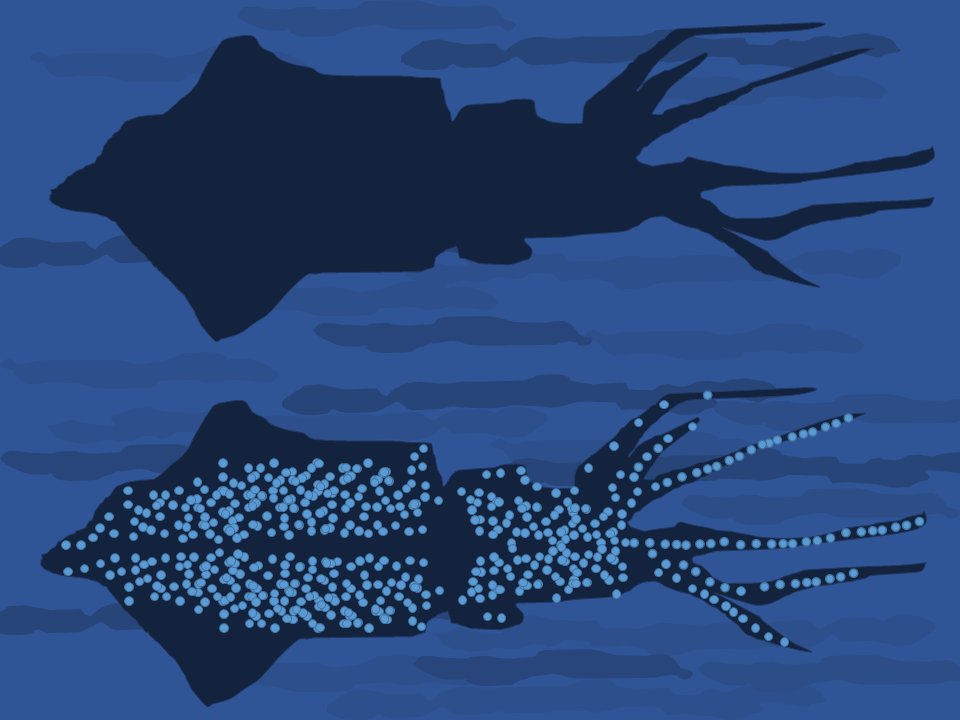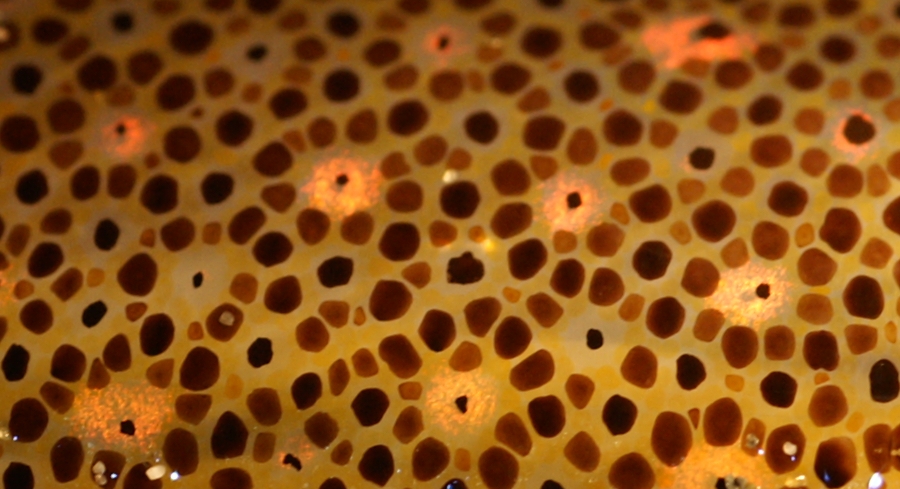|
Photophore
A photophore is a glandular organ that appears as luminous spots on various marine animals, including fish and cephalopods. The organ can be simple, or as complex as the human eye; equipped with lenses, shutters, color filters and reflectors, however unlike an eye it is optimized to produce light, not absorb it. The bioluminescence can variously be produced from compounds during the digestion of prey, from specialized mitochondrial cells in the organism called photocytes ("light producing" cells), or, similarly, associated with symbiotic bacteria in the organism that are cultured. The character of photophores is important in the identification of deep sea fishes. Photophores on fish are used for attracting food or for camouflage from predators by counter-illumination. Photophores are found on some cephalopods including the firefly squid, which can create impressive light displays, as well as numerous other deep sea organisms such as the pocket shark Mollisquama mississippien ... [...More Info...] [...Related Items...] OR: [Wikipedia] [Google] [Baidu] |
Counter-illumination
Counter-illumination is a method of active camouflage seen in marine animals such as firefly squid and midshipman fish, and in military prototypes, producing light to match their backgrounds in both brightness and wavelength. Marine animals of the mesopelagic (mid-water) zone tend to appear dark against the bright water surface when seen from below. They can camouflage themselves, often from predators but also from their prey, by producing light with bioluminescent photophores on their downward-facing surfaces, reducing the contrast of their silhouettes against the background. The light may be produced by the animals themselves, or by symbiotic bacteria, often ''Aliivibrio fischeri''. Counter-illumination differs from countershading, which uses only pigments such as melanin to reduce the appearance of shadows. It is one of the dominant types of aquatic camouflage, along with transparency and silvering. All three methods make animals in open water resemble their environment. C ... [...More Info...] [...Related Items...] OR: [Wikipedia] [Google] [Baidu] |
Histioteuthis Heteropsis
''Histioteuthis heteropsis'' (''H. heteropsis''), also known as the strawberry squid, is a species of small cock-eyed squid. The scientific nomenclature of these squid stems from their set of differently sized eyes, one being small and blue and the other being large and yellow. It is thought that the large eye is used to see objects against dim light, while the smaller eye is more able to view bioluminescent light sources. The squid’s vernacular name arose due to its rich red skin pigmentation and the presence of photophores along its body, making it appear like a strawberry with seeds. ''H. heteropsis'' live in the ocean’s mesopelagic zone and are found in the California Current and the Humboldt Current. Little is known about their specific feeding and mating behaviors, although their inking patterns have been subject to study. They are not easily disturbed, and only ink when provoked. ''H. heteropsis'' was discovered by Berry in 1913 and exhibited publicly for the first t ... [...More Info...] [...Related Items...] OR: [Wikipedia] [Google] [Baidu] |
Chromophore
A chromophore is the part of a molecule responsible for its color. The color that is seen by our eyes is the one not absorbed by the reflecting object within a certain wavelength spectrum of visible light. The chromophore is a region in the molecule where the energy difference between two separate molecular orbitals falls within the range of the visible spectrum. Visible light that hits the chromophore can thus be absorbed by exciting an electron from its ground state into an excited state. In biological molecules that serve to capture or detect light energy, the chromophore is the moiety that causes a conformational change in the molecule when hit by light. Conjugated pi-bond system chromophores Just like how two adjacent p-orbitals in a molecule will form a pi-bond, three or more adjacent p-orbitals in a molecule can form a conjugated pi-system. In a conjugated pi-system, electrons are able to capture certain photons as the electrons resonate along a certain distance ... [...More Info...] [...Related Items...] OR: [Wikipedia] [Google] [Baidu] |
Firefly Squid
The firefly squid (''Watasenia scintillans''), also commonly known as the sparkling enope squid or hotaru-ika in Japan, is a species of squid in the family Enoploteuthidae. It is the sole species in the monotypic genus ''Watasenia''. These tiny squid are found on the shores of Japan in springtime during spawning season, but spend most of their lives in deeper waters between . They are bioluminescent organisms and emit blue light from photophores, which some scientists have hypothesized could be used for communication, camouflage, or attracting food, but it is still unclear in the scientific community exactly how this species uses their bioluminescence. The firefly squid is a predator and actively hunts its food, which includes copepods, small fish, and other squids. The lifespan of a firefly squid is about one year. At the end of their lives females return close to shore to release their eggs, and then die shortly thereafter. This mass migration of firefly squid to the shore is a ... [...More Info...] [...Related Items...] OR: [Wikipedia] [Google] [Baidu] |
Histioteuthis Reversa (Michael Vecchione, NOAA)
''Histioteuthis reversa'', commonly known as the reverse jewel squid or the elongate jewel squid, is a species of cock-eyed squid, so called because the eyes are dissimilar. It occurs at moderate depths in the Atlantic Ocean and Mediterranean Sea and is also known from the Indian Ocean. Description ''Histioteuthis reversa'' grows to a mantle length of about . The head bears four pairs of robust arms, a pair of tentacles and two unequal-sized eyes and the main body mass is enclosed in the mantle. The arms are less than one and a half times the length of the mantle. The outer arms are not joined to each other by a web and the inner arms are connected by a vestigial web remnant. The suckers on the arms are globular, usually with teeth on the margin, and the suckers on the terminal portion of the tentacles are in five or six rows, with larger suckers in the central rows. The mantle is cup-shaped and elongates considerably in females when they mature. The fins are a third to a half t ... [...More Info...] [...Related Items...] OR: [Wikipedia] [Google] [Baidu] |
Chromatophore
Chromatophores are cells that produce color, of which many types are Biological pigment, pigment-containing cells, or groups of cells, found in a wide range of animals including amphibians, fish, reptiles, crustaceans and cephalopods. Mammals and birds, in contrast, have a class of cells called melanocytes for animal coloration, coloration. Chromatophores are largely responsible for generating skin and eye color, eye colour in ectothermic animals and are generated in the neural crest during embryonic development. Mature chromatophores are grouped into subclasses based on their colour (more properly "hue") under white light: xanthophores (yellow), erythrophores (red), iridophores (reflective / iridescence, iridescent), leucophores (white), melanophores (black/brown), and cyanophores (blue). While most chromatophores contain pigments that absorb specific wavelengths of light, the color of leucophores and iridophores is produced by their respective scattering and optical interference ... [...More Info...] [...Related Items...] OR: [Wikipedia] [Google] [Baidu] |
Bioluminescence
Bioluminescence is the production and emission of light by living organisms. It is a form of chemiluminescence. Bioluminescence occurs widely in marine vertebrates and invertebrates, as well as in some fungi, microorganisms including some bioluminescent bacteria, and terrestrial arthropods such as fireflies. In some animals, the light is bacteriogenic, produced by symbiotic bacteria such as those from the genus ''Vibrio''; in others, it is autogenic, produced by the animals themselves. In a general sense, the principal chemical reaction in bioluminescence involves a light-emitting molecule and an enzyme, generally called luciferin and luciferase, respectively. Because these are generic names, luciferins and luciferases are often distinguished by the species or group, e.g. firefly luciferin. In all characterized cases, the enzyme catalyzes the oxidation of the luciferin. In some species, the luciferase requires other cofactors, such as calcium or magnesium ions, and somet ... [...More Info...] [...Related Items...] OR: [Wikipedia] [Google] [Baidu] |
Dorsal Fin
A dorsal fin is a fin located on the back of most marine and freshwater vertebrates within various taxa of the animal kingdom. Many species of animals possessing dorsal fins are not particularly closely related to each other, though through convergent evolution they have independently evolved external superficial fish-like body plans adapted to their marine environments, including most numerously fish, but also mammals such as cetaceans (whales, dolphins, and porpoises), and even extinct ancient marine reptiles such as various known species of ichthyosaurs. Most species have only one dorsal fin, but some have two or three. Wildlife biologists often use the distinctive nicks and wear patterns which develop on the dorsal fins of large cetaceans to identify individuals in the field. The bony or cartilaginous bones that support the base of the dorsal fin in fish are called ''pterygiophores''. Functions The main purpose of the dorsal fin is to stabilize the animal against rollin ... [...More Info...] [...Related Items...] OR: [Wikipedia] [Google] [Baidu] |
Gigantactis
''Gigantactis'' is a genus of deep-sea fish of the family Gigantactinidae, first described in 1902 by August Brauer. The species in this genus are poorly known and found in all oceans, at depths of . The most striking feature of these fish is extremely enlarged first filament of dorsal fin, called the illicium, with bioluminescent photophore at its end. (In ''G. longicauda'' the length of the illicium can be up to 3.3 times the standard length of the fish.) Species , there are currently 20 recognized extant species in this genus: * '' Gigantactis balushkini'' Kharin, 1984 * '' Gigantactis elsmani'' Bertelsen, Pietsch & Lavenberg, 1981 (Elsman's Whipnose) * '' Gigantactis gargantua'' Bertelsen, Pietsch & Lavenberg, 1981 (Gigantic Whipnose) * '' Gigantactis gibbsi'' Bertelsen, Pietsch & Lavenberg, 1981 * '' Gigantactis golovani'' Bertelsen, Pietsch & Lavenberg, 1981 * '' Gigantactis gracilicauda'' Regan, 1925 * '' Gigantactis herwigi'' Bertelsen, Pietsch & Lavenber ... [...More Info...] [...Related Items...] OR: [Wikipedia] [Google] [Baidu] |
Lanternfish
Lanternfishes (or myctophids, from the Greek μυκτήρ ''myktḗr'', "nose" and ''ophis'', "serpent") are small mesopelagic fish of the large family Myctophidae. One of two families in the order Myctophiformes, the Myctophidae are represented by 246 species in 33 genera, and are found in oceans worldwide. Lanternfishes are aptly named after their conspicuous use of bioluminescence. Their sister family, the Neoscopelidae, are much fewer in number but superficially very similar; at least one neoscopelid shares the common name "lanternfish": the large-scaled lantern fish, '' Neoscopelus macrolepidotus''. Lanternfish are among the most widely distributed, diverse and populous vertebrates, with some estimates suggesting that they may have a total global biomass of 1.8 to 16 gigatonnes, accounting for up to 65% of all deep-sea fish biomass. Commercial fisheries for them exist off South Africa, in the sub-Antarctic, and in the Gulf of Oman. Description Lanternfish typically ha ... [...More Info...] [...Related Items...] OR: [Wikipedia] [Google] [Baidu] |
Mollisquama Mississippiensis
''Mollisquama mississippiensis'' or the American pocket shark is a species of pocket shark native to the Gulf of Mexico. It is the second species of pocket shark to be described. Discovery The shark was first discovered by scientists from Tulane University that were conducting a study on sperm whales in 2010. In 2013, the National Oceanic and Atmospheric Administration identified it as a pocket shark, the first to be found in its region. A previously found specimen of a different pocket shark species was caught off the coast of Chile in 1979 and was used to identify the two different species due to their differences in size, vertebrae and numerous light-producing photophores. Description The head is bulbous, resembling that of a whale. The shark is very small, at only . Near the gill A gill () is a respiratory organ that many aquatic organisms use to extract dissolved oxygen from water and to excrete carbon dioxide. The gills of some species, such as hermit crabs, hav ... [...More Info...] [...Related Items...] OR: [Wikipedia] [Google] [Baidu] |

.jpeg/1200px-Fall_Leaves_(199582361).jpeg)




